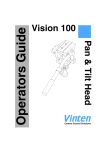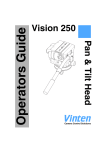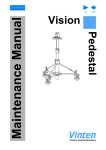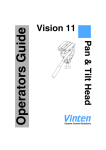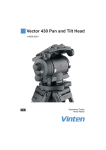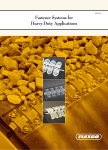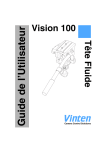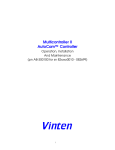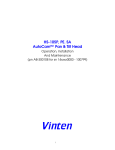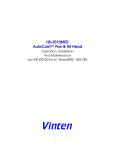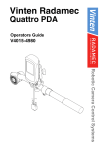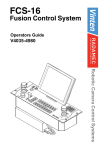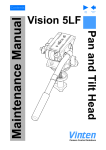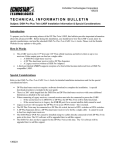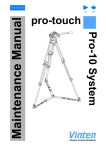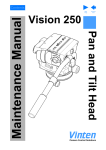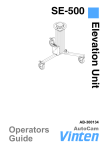Download Vector 450 P an & Tilt Head
Transcript
Pan & Tilt Head Operators Guide Vector 450 Vinten Camera Control Solutions Vision 450 Pan and Tilt Head Publication Part No. 3805-8 Issue 1 Copyright © Vinten Broadcast Limited 2004 All rights reserved throughout the world. No part of this document may be stored in a retrieval system, transmitted, copied or reproduced in any way including, but not limited to, photocopy, photograph, magnetic or other record without the prior agreement and permission in writing of Vinten Broadcast Limited. Vinten, Vector, QuickFit and Quickfix are registered trademarks of Vinten Broadcast Limited. Safety - read this first Warning Symbols in this Operators Guide Where there is a risk of personal injury, injury to others, or damage to the pan and tilt head or associated equipment, comments appear, highlighted by the word WARNING! and supported by the warning triangle symbol. Technical data Weight 15 kg (33 lb) Height to wedge adaptor mounting face 24.8 cm (11.3 in.) Length 22.5 cm (8.9 in.) Width 34.2 cm (13.5 in.) Typical payload 10-45 kg (22-99 lb) - See balance graph Tilt range ±90° Pan range 360° Operating temperature range - 40°C to + 60°C (- 40°F to + 140°F) Pedestal/tripod fixing 150 mm ball base or Four-hole flat base with `Quickfix' mounting and provision for Mitchell adaptor Further information For further information or advice regarding this pan and tilt head, please contact Vinten Broadcast Limited, your local Vinten distributor (see back cover) or visit our website. For details on maintenance and spare parts, please refer to the Vector 450 Pan and Tilt Head Maintenance Manual and Illustrated Parts List (Publication Part No. 3805-9) This is obtainable from Vinten Broadcast Limited or your local Vinten distributor. For information on-line, visit our website at www.vinten.com. 3 Contents Page Safety - read this first . . . . . . . . . . . . . . . . . . . . . . . . . . . . . . . . . . . . . . . . . . . . . . . . . . . . . . . . 3 Technical data . . . . . . . . . . . . . . . . . . . . . . . . . . . . . . . . . . . . . . . . . . . . . . . . . . . . . . . . . . . . . . 3 Further information. . . . . . . . . . . . . . . . . . . . . . . . . . . . . . . . . . . . . . . . . . . . . . . . . . . . . . . . . . 3 Introduction . . . . . . . . . . . . . . . . . . . . . . . . . . . . . . . . . . . . . . . . . . . . . . . . . . . . . . . . . . . . . . . . 8 Operation Installing the head . . . . . . . . . . . . . . . . . . . . . . . . . . . . . . . . . . . . . . . . . . . . . . . . . . . . . . . . 11 Pan bars. . . . . . . . . . . . . . . . . . . . . . . . . . . . . . . . . . . . . . . . . . . . . . . . . . . . . . . . . . . . . . . . 11 Fitting a camera . . . . . . . . . . . . . . . . . . . . . . . . . . . . . . . . . . . . . . . . . . . . . . . . . . . . . . . . . . 11 Balancing the head . . . . . . . . . . . . . . . . . . . . . . . . . . . . . . . . . . . . . . . . . . . . . . . . . . . . . . . 12 Locking the platform . . . . . . . . . . . . . . . . . . . . . . . . . . . . . . . . . . . . . . . . . . . . . . . . . . . . . . 13 Pan and tilt brakes . . . . . . . . . . . . . . . . . . . . . . . . . . . . . . . . . . . . . . . . . . . . . . . . . . . . . . . . 14 Pan and tilt drag. . . . . . . . . . . . . . . . . . . . . . . . . . . . . . . . . . . . . . . . . . . . . . . . . . . . . . . . . . 14 Digital display. . . . . . . . . . . . . . . . . . . . . . . . . . . . . . . . . . . . . . . . . . . . . . . . . . . . . . . . . . . . 15 Servicing General . . . . . . . . . . . . . . . . . . . . . . . . . . . . . . . . . . . . . . . . . . . . . . . . . . . . . . . . . . . . . . . . 17 Routine maintenance. . . . . . . . . . . . . . . . . . . . . . . . . . . . . . . . . . . . . . . . . . . . . . . . . . . . . . 17 Cleaning. . . . . . . . . . . . . . . . . . . . . . . . . . . . . . . . . . . . . . . . . . . . . . . . . . . . . . . . . . . . . . . . 17 Electronic unit battery replacement . . . . . . . . . . . . . . . . . . . . . . . . . . . . . . . . . . . . . . . . . . . 18 Balance mechanism digital display calibration. . . . . . . . . . . . . . . . . . . . . . . . . . . . . . . . . . . 19 Converting the base. . . . . . . . . . . . . . . . . . . . . . . . . . . . . . . . . . . . . . . . . . . . . . . . . . . . . . . 20 Adjustments . . . . . . . . . . . . . . . . . . . . . . . . . . . . . . . . . . . . . . . . . . . . . . . . . . . . . . . . . . . . . 21 Parts List . . . . . . . . . . . . . . . . . . . . . . . . . . . . . . . . . . . . . . . . . . . . . . . . . . . . . . . . . . . . . . . . . 23 Associated publication Vector 450 Pan and Tilt Head Maintenance Manual Publication Part No. 3805-9 4 (19) (1) (18) (2) (17) (3) (16) (4) (15) (5) (14) (6) (13) (7) (12) (8) (11) (10) (9) Vision 450 (Right-Hand Side, with Spherical Base) (1) Camera wedge (2) EFP Quickfit adaptor (3) Quickfit adaptor safety lock plate (4) Quickfit adaptor lock bar (5) Sliding plate adjustment handle (6) Carrying handle (7) Centre lock plunger (8) Balance knob (9) Tilt brake lever (10) Pan brake lever (11) Bowl clamp 5 (12) 150 mm spherical base (13) Illuminated level bubble (14) Timer button (15) Digital display (16) Illumination button (17) Centre lock release lever (18) Quickfit adaptor mounting screws (19) Camera fixing screws 6 (20) (27) (21) (26) (22) (25) (23) (24) Vision 450 (Left-Hand Side, with Flat Base) (20) Sliding plate clamp lever (21) Pan bar mounting (22) Tilt drag adjustment knob (23) Pan drag adjustment knob (24) Mitchell adaptor key way (25) Four-hole mounting plate (26) Battery cover (27) Graduated sliding plate 7 Introduction The Vector 450 pan and tilt head embodies a unique and patented spring counterbalancing mechanism, thin film (TF) drag assemblies for pan and tilt motions and an adjustable camera mounting plate. Perfect balance The spring counterbalancing mechanism comprises four springs operating against a three-dimensional cam connected to the camera mounting platform. The balance mechanism is adjusted by a knob (8), situated on the right front lower part of the main body, which varies the mechanical advantage between the cam and the springs. The knob has a ‘push in and turn’ action and is fitted with a clutch to prevent inadvertent damage to the balance mechanism. Maximum and minimum payloads that can be balanced, and tilt ranges, are dependent on the weight of the camera and accessories and on the centre of gravity (C of G) height. The graph shows the range of load and C of G height that can be maintained in balance. The shaded area of graph corresponds to those load/C of G combinations that can be balanced over the full tilt range. The area to the right indicate the progressively reducing tilt range with greater load and higher C of G. in. 8 Centre of Gravity Height 7 mm 200 175 6 150 5 125 4 100 3 75 2 50 ±90° 0 0 20 20 40 40 60 80 60 100 120 80 140 160 180 kg lb Total Payload Balance graph 8 Where a load/C of G combination falls outside of the graph it will be necessary to increase or decrease the weight or the C of G height - if possible - to enable the head to balance the load. A digital display (15) indicates the setting of the balance mechanism on a scale of 0-100. The display is active when the balance knob (8) is turned and extinguishes automatically approximately 15 seconds after adjustments are complete. The display may be lit by pressing the illumination button (16). The battery for the system is housed in a compartment in the base of the head, closed by a cover (25). TF drag Both the pan and tilt mechanisms incorporate the Vinten thin film (TF) system to ensure smooth movement of the camera about these axes and are fitted with control knobs (22)(23) to adjust the drag setting. The whip-pan facility is unaffected by the pan drag setting. Both drag knobs are provided with scales illuminated by the button (16). The lights will go out after approximately 15 seconds. Pan and tilt brakes Friction brakes on each axis allow the head to be locked at any chosen position. The operating levers for both brakes (9)(10) are located side-by-side on the right-hand side of the head. Centre lock A centre lock (7) allows the head to be locked in the horizontal position. Illuminated level bubble A level bubble (13), illuminated by pressing the illumination button (16), is fitted to the rear of the head. The same button also illuminates the pan and tilt drag knob scales and the LCD display. The light will go out after approximately 15 seconds. Pan bar Pan bar mounting points (21) are located at the rear of the head, on either side of the camera mounting platform. A telescopic pan bar is supplied and is attached using a pan bar clamp, with angular adjustment available on the mount serrations. A second pan bar may be fitted. EFP Quickfit adaptor The camera is attached to the head by means of a EFP Quickfit adaptor (2), which is mounted on a graduated sliding plate (27). The position of the slide plate is adjusted by a retractable knob (5) and a clamp (20) is provided to hold the slide plate in position. Tripod/pedestal mounting The Vector 450 pan and tilt head is available with either a 150 mm ball base or a flat base. The two base assemblies are interchangeable (See Converting the base on page 20). Adaptors are available which enable the heads to be installed on tripods or pedestals fitted with other mountings. These are listed in the Parts List under Optional accessories. 150 mm ball base The 150 mm ball base is designed for installation on a compatible Vinten tripod. 9 Flat base The flat base is has a standard Vinten four-hole mounting plate (25), which includes a `Quickfix' mounting and provision for a Mitchell adaptor (24). Carrying handle A retractable carrying handle (6) is provided on the right-hand side of the head. The handle is spring-loaded to the closed position. Electronic unit An electronic unit is fitted to the rear of the head, powered by a battery housed in a compartment (26) in the base of the head. The unit comprises a two-row digital display (15) and two push-button buttons - an illumination button (16), which illuminates the LCD display, levelling bubble and the pan and tilt drag knob scales for 15 seconds, and a timer button (14). Pressed singly or in conjunction with each other, the buttons provide control of the time, stopwatch and calibration functions. For a detailed description of each function, see Digital display on page 15. 10 Operation Installing the head WARNING! If using lifting equipment to raise or lower the head, use slings or straps. DO NOT use shackles. Ensure that slings or straps are securely attached to the head. A suitable lifting point is at the rear of the platform, accessed by moving the sliding plate (27) to the fully forward position. DO NOT attach lifting slings or straps to the carrying handle. To install a head with a ball mount, remove the bowl clamp assembly (11) from the head, position the head on the tripod and refit the bowl clamp assembly from below. Level the head with the aid of the level bubble (13) and tighten the bowl clamp. The level bubble may be illuminated by pressing the switch (16). The light will go out after approximately 15 seconds. The flat base head may be installed on a standard ‘Vinten’ tripod or pedestal using the four mounting bolts and washers provided or by using a `Quickfix' adaptor. A Mitchell adaptor may also be used. WARNING! Before installing the head, hold a fixing bolt in position and check that the threaded end does not project more than 12 mm (15/32 in.) above the mounting face After mounting the head on a tripod, use the level bubble (13) to set it level. The level bubble may be illuminated by pressing the illumination button (16). The light will go out after approximately 15 seconds. Pan bars Fit the pan bars on the mountings (21) and adjust the position of each one before tightening the clamps. Adjust the length of the telescopic pan bar. Optional fixed and short fixed pan bars are available (see Main assemblies in the Parts List). Fitting a camera WARNING! Do not rely on the tilt brake when changing the payload. Always engage the centre lock. Ensure that the weight and C of G height of the total payload is within the range for which the head is designed If installing on a pedestal, lock the pedestal in the fully depressed position before installing the camera. The camera is attached to the head by means of a EFP Quickfit adaptor. To fit a camera, proceed as follows: Free the camera wedge (1) from the EFP Quickfit adaptor by sliding the safety lock plate (3) fully forward and pushing in the lock bar (4). Attach the wedge (1) to the camera/lens using the camera fixing screws (19). 11 Ensure that the centre lock (7) is engaged (see Locking the platform on page 13). Insert the forward edge of the camera wedge (1) into the Quickfit adaptor. Push the wedge down until the lock bar (4) clicks out. Slide the safety lock plate (3) backwards to hold the lock bar (4) in position. Install the remainder of the payload (lens, zoom and focus controls, viewfinder, prompter etc). Balancing the head NOTE: It is important that the pan bar(s) and all camera accessories (lens, zoom and focus controls, viewfinder, prompter etc.) are fitted in their operational position before balancing the head. Any equipment fitted or adjusted later will unbalance the head. Balancing the Vector 450 head achieves two objectives. Firstly, when a head is correctly balanced the operator will need a minimum amount of even effort to move the head. Secondly, once balanced, the head and its payload can be set to any tilt position and the head will maintain this position with ‘hands off’. The graph shows the range of load and C of G height that can be maintained in balance. The shaded area of graph corresponds to those load/C of G combinations that can be balanced over the full tilt range. The area to the right indicate the progressively reducing tilt range with greater load and higher C of G. Fore and aft balance When positioning the payload it is important to be aware of the potential danger of an unbalanced payload falling away suddenly. Before disengaging the centre lock, push in and turn the balance adjustment knob (8) to its mid point setting (50 on the digital display). Depending on the payload weight, it may be necessary to increase or decrease this setting to enable the payload to be correctly balanced fore and aft. Balance the payload fore and aft as follows: Ensure that the centre lock is engaged (see “Locking the platform” on page 13) and that the camera and all accessories are fitted. Turn the tilt drag adjustment knob (22) to its minimum setting. Push in and turn the balance adjustment knob (8) to its mid point setting. WARNING! Be prepared to prevent the head falling away suddenly. In the event of the head falling away violently, increase the setting on the balance adjustment knob (8). Holding the pan bar to steady the platform, disengage the centre lock (see “Locking the platform” on page 13). 12 Release the sliding plate clamp (20) and pull out the sliding plate adjustment knob (5) until it engages with the platform drive. Turn the knob to move the sliding plate fore and aft to achieve horizontal balance. NOTE: The sliding plate is graduated to facilitate balancing. If the balance setting of the payload is known, turn the knob until that setting is reached. The horizontal balance is correct when no perceptible tilting force can be felt on the pan bar with the platform level. Apply the sliding plate clamp (20) and push in the adjustment knob (5) to its stowed position. If there is insufficient movement in the sliding plate to achieve balance, reposition the Quickfit adaptor (see Repositioning the EFP Quickfit adaptor on page 21), refit the load and repeat the horizontal balancing procedure. The sliding plate is graduated. Make a note of the position to facilitate rebalancing this particular payload. Payload weight and C of G height adjustment When fore and aft balance has been achieved, carry out the payload weight and C of G height adjustment as follows: NOTE: If the digital balance setting of the payload is known, push in and turn the balance knob (8) until the digital display (15) shows that setting. Using the pan bar, tilt the platform forward and backward. When correctly balanced, there should be no perceptible tilting force on the pan bar at any angle of tilt and the head should remain in any tilt position to which it is set. NOTE: Setting the platform level will facilitate adjusting the balance setting If the head tends to fall away when the platform is tilted, set the platform level and push in and turn the balance adjustment knob (8) clockwise to increase the balance setting. If the head tends to spring back to centre, set the platform level and push in and turn the balance adjustment knob (8) counter-clockwise to decrease the balance setting. When the payload weight and C of G height adjustment is complete, check that the fore and aft balance remains satisfactory. Re-adjust the position of the sliding plate if necessary. The digital display (15) will display the balance setting while balance is being adjusted. Make a note of the final setting to facilitate rebalancing this particular payload. After balancing, exercise the head through both axes to confirm that it operates smoothly. Locking the platform The centre lock mechanism is operated by a plunger on the right-hand side of the head. To engage the lock, hold the platform in the horizontal position and push the plunger (7) inwards until it latches and the release lever (17) appears. Use the pan bar to rock the platform slightly whilst pushing the button. To release the centre lock, rock the platform slightly and push down on the release lever (17). 13 Pan and tilt brakes The pan (10) and tilt brakes (9) are operated by levers on the right of the head. The brakes are applied by pushing the appropriate lever down and released by pulling the lever up. The brakes should be applied whenever the camera is left unattended. Pan and tilt drag Both the pan and tilt mechanisms incorporate the Vinten thin film (TF) system to ensure smooth movement of the camera about these axes and are fitted with control knobs to adjust the drag setting. Both drag knobs are provided with illuminated scales, graduated from 0 to 9. To illuminate the scales, press the button (16). The light will go out after approximately 15 seconds. The drag adjustment knobs are mounted on the left-hand side of the head. The smaller pan drag knob (23) is on the front lower part of the main body, with the larger tilt drag knob (22) in the centre on the tilt drag housing. To increase drag, turn the knob clockwise, towards a higher graduation. To decrease drag, turn the knob anti-clockwise, towards a lower graduation.The whip-pan facility is unaffected by the pan drag setting. 14 Digital display The digital display (15) comprises a two-row LCD display. It has three modes of operation, selected by the buttons (14)(16). The display may be illuminated by pressing the illumination button (16). Clock and stopwatch The top row of the display is a 24-hour clock (15.1), which is always visible. This is the default mode. The bottom row is a stopwatch, counting in seconds and minutes from 00:00 to 59:59. To set the clock: Press both buttons (14)(16) momentarily. The hours display will flash. Use the timer button (14) to increment the hours. Press the illumination button (16). The minutes display will flash. Use the timer button (14) to increment the minutes. Press the illumination button (16) to exit and start the clock. To display, start, stop or clear the stopwatch: Momentarily pressing the timer button (14) will display, start, stop or clear the stopwatch in that sequence. Balance Balance mode is active any time the balance adjustment knob (8) is turned (unless the stopwatch is running) and remains active for 15 seconds after adjustment has finished. In this mode the bottom row shows the setting of the balance mechanism on a scale of 0.0 to 100.0 The BAL legend (15.3) is also lit. The top row of the display shows the 24-hour clock. (15.1) (15.2) (16) (14) (15.3) Digital display 15 Calibration This mode allows the balance display to be calibrated (see Balance mechanism digital display calibration on page 19). It is activated by pressing and holding both buttons (14)(16) for five seconds. Low battery The low battery indicator (15.2) will flash whenever the battery requires replacement (see Electronic unit battery replacement on page 18). 16 Servicing General The Vector 450 pan and tilt head is robustly made to high engineering standards and little attention is required to maintain serviceability save regular cleaning. Refer to the appropriate section in the Maintenance Manual if any defect is apparent. Adjustments and repairs should be carried out only by a competent person. Routine maintenance Replace the electronic unit battery whenever the low battery indicator flashes. During use, check the following: Check the effectiveness of the pan and tilt brakes. Reset as necessary. Check the effectiveness of the slide plate clamp. Reset as necessary. Check the operation of the balance mechanism digital display and the illumination of the LCD, level bubble and drag knobs. Replace battery if necessary. No further routine maintenance is required. Cleaning During normal use the only cleaning required should be a regular wipe over with a lint-free cloth. Dirt accumulated during storage or periods of disuse may be removed with a semi-stiff brush. Particular attention should be paid to the wedge location faces of the wedge adaptor. NOTE: Use only detergent-based cleaners. DO NOT use solvent- or oil-based cleaners, abrasives or wire brushes to remove accumulations of dirt as these damage the protective surfaces Use out-of-doors under adverse conditions may require special attention and the head should be covered when not in use. Salt spray should be washed off using fresh water at the earliest opportunity. Sand and dirt act as an abrasive and should be removed using a semi-stiff brush or a vacuum cleaner. 17 Electronic unit battery replacement The battery powers the digital display and illuminates the LCD, the level bubble and the drag knob scales. The battery should be replaced whenever the low battery indicator flashes. NOTE: Removal of the battery will not affect the calibration of the balance mechanism display. Prise out the battery cover (26). Pull the battery (26.1) out of the battery compartment as far as the wiring will allow. Pull the connector (26.2) off the terminals of the old battery and push it onto the terminals of the new battery (26.1). Install the battery (26.1) in the battery compartment, ensuring that the wiring is neatly stowed. Refit the battery cover (26). Press the illumination button (16) and ensure that the balance mechanism digital display (15), the level bubble (13) and drag knob scales (22)(23) are lit for approximately 15 seconds. Turn the balance knob (8) and ensure that the balance display (15) is active for approximately 15 seconds. Reset the clock (see Clock and stopwatch on page 15). (22) (16) (23) (15) (26.2) (13) (26.1) (8) (26) Battery replacement 18 Balance mechanism digital display calibration The digital display (15) indicates the setting of the balance mechanism on a scale of 0 (minimum setting) to 100 (maximum setting). In the unlikely event of this system requiring calibration, proceed as follows: NOTE: If more than five minutes is allowed to elapse before completion, the system will shut down and revert to its previous settings. Level the platform and apply centre lock (7). Press and hold both buttons (14)(16) until CAL is displayed on the top row of the display. Push in and turn the balance knob (8) counterclockwise until its minimum end stop is reached, then turn back two full turns. The bottom row of the display will flash 0. Press and release the timer button (14). The bottom row of the display will flash 100. Push in and turn the balance knob (8) clockwise until its maximum end stop is reached, then turn back two full turns. Press and release the timer button (14). Calibration is now complete and the display will revert to the default clock mode. After calibration, rebalance the head (see “Balancing the head” on page 12). (7) (8) (16) (15) (14) Balance mechanism digital display calibration 19 Converting the base Spares kits are available to convert the head from ball base to flat base versions and vice versa. Kit 3805-900SP comprises a ball base, bowl clamp and fixing hardware; while kit 3805-901SP has a flat base, mounting bolts and washers, a spanner and fixing hardware. To change the base: Remove the payload, then remove the head from its mounting. On the base, remove eight screws (12.1) and separate the base (12) from the head. Position the replacement base on the head and secure with eight screws (12.1), using Loctite 222E. (12) (12.1) (11) Converting the base 20 Adjustments To enable the payload to be correctly balanced, the EFP Quickfix adaptor may require repositioning. The following adjustments may be necessary after prolonged use: The platform slide clamp may require adjustment. The pan and tilt brakes may require adjustment. Repositioning the EFP Quickfit adaptor The EFP Quickfit adaptor (2) is secured by six screws (18) which pass through the adaptor into the sliding plate (27). The EFP Quickfit adaptor may be fitted in three positions. WARNING! Overlong screws will prevent the sliding plate from operating. Always use the screws provided (M4 x 12 mm). To reposition the EFP Quickfit adaptor: Engage the centre lock (see Locking the platform on page 13) and remove the payload. Hold the body of the EFP Quickfit adaptor (2) and remove the six securing screws (18). Reposition the Quickfit adaptor (2) on the sliding plate (27), ensuring that the lock bar (4) is towards the rear. Insert the six screws (18) in the holes in the adaptor and tighten. (20.1) (20) (20.2) Platform slide clamp adjustment 21 Platform slide clamp adjustment The platform slide clamp should be set so that, in the up or clamped position it prevents the platform slide from being moved, while in the down or released position it allows free adjustment of the slide. To adjust the clamp, proceed as follows: Pull the slide clamp lever (20) fully upwards. Slacken the clamp screw (20.2). Turn the slotted shaft (20.1) fully clockwise to apply the clamp. Tighten the clamp screw (20.2). Move the lever (20) over its full range and ensure that, in the clamped position, it prevents the slide from being moved, while in the released position it allows free adjustment of the slide. Re-adjust if necessary. Pan and tilt brake adjustment The pan (10) and tilt brakes (9) are operated by levers on the right of the head. The brakes are applied by pushing the appropriate lever down and released by pulling the lever up. If the brakes become ineffective, adjustment should be carried out by qualified personnel in accordance with the Maintenance Manual (Publication Part No. 3805-9). 22 Parts List The following list includes the main assemblies, user-replaceable spare parts and optional accessories. For further information regarding repair or spare parts, please contact Vinten Broadcast Limited or your local distributor. For information on-line, visit our website at www.vinten.com Main assemblies Vector 450 pan and tilt head - flat base 3805-3F Vector 450 pan and tilt head - spherical base 3805-3S EFP Quickfit adaptor 3761-3 Standard wedge plate 3761-13 Telescopic pan bar and clamp 3219-82 Fixed pan bar and clamp 3219-94 Short fixed pan bar and clamp 3219-93 Fixing bolt L054-714 Washer - for fixing bolt L602-122 Spanner - for fixing bolts J551-001 User-replaceable spare parts Battery - 9V, 6LR61 (PP3, 6AM6, MN1604, E-BLOCK or equivalent) C550-023 Optional accessories Spherical base adaptor kit 3805-900SP Flat base adaptor kit 3805-901SP Heavy-duty Quickfix adaptor Levelling adaptor Quickfix to 4-bolt flat base 3490-3 3328-30 Lightweight Mitchell adaptor 3103-3 Heavy-duty Mitchell adaptor for Vinten pedestal mounting in conjunction with Hi-hat adaptor Part No. 3055-3 3724-3 23























